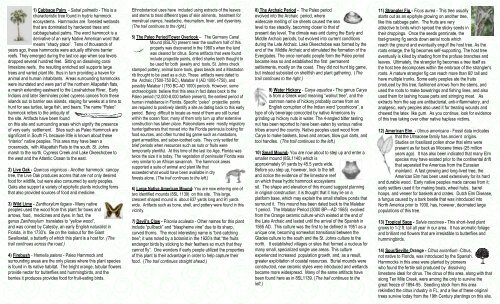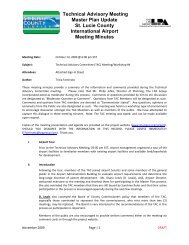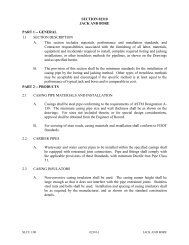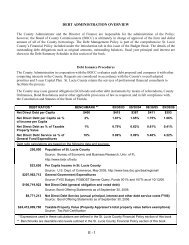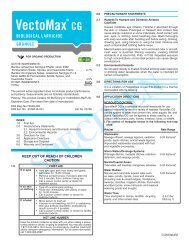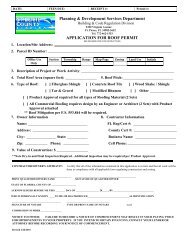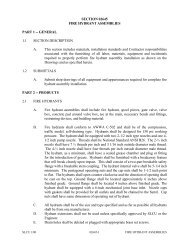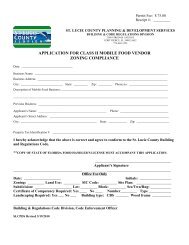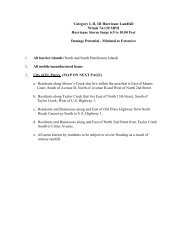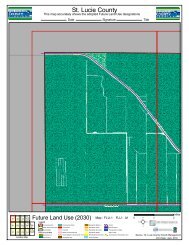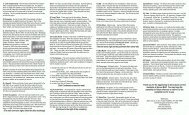Paleo Hammock Preserve - St. Lucie County
Paleo Hammock Preserve - St. Lucie County
Paleo Hammock Preserve - St. Lucie County
You also want an ePaper? Increase the reach of your titles
YUMPU automatically turns print PDFs into web optimized ePapers that Google loves.
1) Cabbage Palm - Sabal palmetto - This is a<br />
characteristic tree found in hydric hammock<br />
ecosystems. <strong>Hammock</strong>s are forested wetlands<br />
that are dominated by hardwood trees and<br />
cabbage/sabal palms. The word hammock is a<br />
derivative of an early Native American word that<br />
means “shady place”. Tens of thousands of<br />
years ago, these hammocks were actually offshore barrier<br />
reefs. They emerged during the last ice age when sea levels<br />
dropped several hundred feet. Sitting on dissolving coral<br />
limestone reefs, the resulting enriched soil supports large<br />
trees and varied plant life, thus in turn providing a haven for<br />
animal and human inhabitants. Areas surrounding hammocks<br />
were inundated and were part of the northern Allapattah flats,<br />
a marsh extending eastward to the Loxahatchee River. Early<br />
Indians and later Seminoles poled cypress canoes from these<br />
islands out to barrier sea islands, staying for weeks at a time to<br />
hunt for sea turtles, large fish, and bears. The name “<strong>Paleo</strong>”<br />
hammock refers to the antiquity of<br />
the site. Artifacts have been found<br />
on this site and surrounding areas which signify the presence<br />
of very early settlement. Sites such as <strong>Paleo</strong> <strong>Hammock</strong> are<br />
significant in South FL because little is known about these<br />
“interior” native peoples. This area may have been a<br />
crossroads, with Allapattah Flats to the south, <strong>St</strong>. Johns<br />
marsh to the north, Cypress Creek and Lake Okeechobee to<br />
the west and the Atlantic Ocean to the east.<br />
2) Live Oak - Quercus virginicus - Another hammock canopy<br />
tree, the Live Oak produces acorns that are not only desired<br />
food for wildlife, but were also consumed by early peoples.<br />
Oaks also support a variety of epiphytic plants including ferns<br />
that also provided sources of food and medicine.<br />
3) Wild Lime - Zanthoxylum fagara - Many native<br />
peoples used the wood from this plant for bows and<br />
arrows, food, medicines and dyes. In fact, the<br />
genus Zanthoxylum translates to “yellow wood”,<br />
and was coined by Catesby, an early English naturalist in<br />
Florida, in the 1730’s. Be on the lookout for the Giant<br />
Swallowtail, a butterfly of which this plant is a host for. (The<br />
trail continues across the road.)<br />
4) Firebush - Hamelia patens - <strong>Paleo</strong> <strong>Hammock</strong> and<br />
surrounding areas are the only places where this plant species<br />
is found in its native habitat. The bright orange, tubular flowers<br />
provide nectar for butterflies and hummingbirds, and the<br />
berries it produces provides food for fruit-eating birds.<br />
Ethnobotanical uses have included using extracts of the leaves<br />
and stems to treat different types of skin ailments, treatment for<br />
menstrual cramps, headache, rheumatism, fever, and dysentery.<br />
(The trail continues to the right.)<br />
5) The <strong>Paleo</strong> Period/Tower Overlook – The Germany Canal<br />
Mound (8SL70) present near the southern half of this<br />
property was discovered in the 1980’s when the land<br />
was cleared for citrus. Some artifacts that were found<br />
include projectile points, drilled sharks teeth thought to<br />
be used for both jewelry and tools, <strong>St</strong>. Johns check<br />
stamped pottery, animal bone tools, glass beads and a Mastodon<br />
rib thought to be used as a club. These artifacts were dated to<br />
the Archaic (7500-750 BC), Malabar II (AD 1000-1750), and<br />
possibly Malabar I (750 BC-AD 1000) periods. However, some<br />
archaeologists believe that this area in fact dates back to the<br />
<strong>Paleo</strong> period (12,000-8,000 before present), the earliest period of<br />
human inhabitance in Florida. Specific “paleo” projectile points<br />
are required to positively identify a site as dating back to this early<br />
period. Being difficult to locate as most of them are still buried<br />
within the ocean floor, many of them only turn up after extensive<br />
construction has taken place. <strong>Paleo</strong>indians were mostly migratory<br />
hunter/gatherers that moved into the Florida peninsula looking for<br />
food sources, and often hunted big game such as mastodons,<br />
giant armadillos, and saber-toothed cats. They only settled for<br />
brief periods when resources such as nuts or fruits were<br />
temporarily plentiful. At this time of the last Ice Age, Florida was<br />
twice the size it is today. The vegetation of peninsular Florida was<br />
very similar to an African savannah. The hammock areas<br />
supported a suite of animal and plant life that<br />
exceeded what would have been available in dry<br />
forests alone. (The trail continues to the left.)<br />
6) Large Native American Mound- You are now entering one of<br />
two identified mounds (8SL 1139) on this site. This large,<br />
crescent shaped mound is about 637 yards long and 91 yards<br />
wide. Artifacts such as bone, shell, and pottery were found in this<br />
vicinity.<br />
7) Devil’s Claw - Pisonia aculeata - Other names for this plant<br />
include “pullback” and “blaspheme vine” due to its sharp,<br />
curved thorns. The most interesting name is “bird-catching<br />
tree”; it was noted by a botanist in the 1920’s that “the fruits<br />
endanger birds by sticking to their feathers so much that they<br />
cannot fly”. One wonders if early people utilized the properties<br />
of this plant to their advantage in order to help capture their<br />
food. (The trail continues straight ahead.)<br />
8) The Archaic Period - The <strong>Paleo</strong> period<br />
evolved into the Archaic period, where<br />
widescale melting of ice sheets caused the sea<br />
level to rise steadily, becoming closer to that of<br />
present day level. The climate was arid during the Early and<br />
Middle Archaic periods, but evolved into current conditions<br />
during the Late Archaic. Lake Okeechobee was formed by the<br />
end of the Middle Archaic and stimulated the formation of the<br />
Everglades. The once nomadic people form the <strong>Paleo</strong> period<br />
became less so and established the first permanent<br />
settlements, mostly on the coast. They did not hunt big game,<br />
but instead subsisted on shellfish and plant gathering. (The<br />
trail continues to the right.)<br />
9) Water Hickory - Carya aquatica - The genus Carya<br />
is from a Greek word meaning “walnut tree”, and the<br />
common name of hickory probably comes from an<br />
English corruption of the Indian word “pocohicora”, a<br />
type of oily beverage concocted by native Americans by<br />
grinding up hickory nuts in water. The 4-angled bitter tasting<br />
nut has been reported to have been eaten by various native<br />
tribes around the country. Native peoples used wood from<br />
Carya to make baskets, bows and arrows, blow gun darts, and<br />
tool handles. (The trail continues to the left.)<br />
10) Small Mound- You are now about to step up and enter a<br />
smaller mound (8SL1140) which is<br />
approximately 91 yards by 45.5 yards wide.<br />
Before you step up, however, look to the left<br />
and notice the evidence of the limestone reef<br />
on which these hydric hammock ecosystems<br />
sit. The shape and elevation of this mound suggest planning<br />
in original construction; it is thought that it may lie on a<br />
platform base, which may explain the small shallow ponds that<br />
surround it. This mound has been dated back to the Malabar<br />
1 period. The Malabar Period (3000 BP—AD 1565) evolved<br />
from the Orange ceramic culture which existed at the end of<br />
the Late Archaic and lasted until the arrival of the Spanish in<br />
1565 AD. This culture was the first to be defined in 1951 as a<br />
unique one, becoming somewhat transitional between the<br />
Glades culture to the south and the <strong>St</strong>. Johns culture to the<br />
north. It established villages or sites that formed a nucleus for<br />
many small, specialized single use areas. This culture<br />
experienced increased population growth, and, as a result,<br />
greater exploitation of coastal resources. Burial mounds were<br />
constructed, new ceramic styles were introduced and wetlands<br />
became more widespread. Many of the same artifacts have<br />
been found here as in 8SL1139. (The trail continues to the<br />
left.)<br />
11) <strong>St</strong>rangler Fig - Ficus aurea - This tree usually<br />
starts out as an epiphyte growing on another tree,<br />
like this cabbage palm. The fruits are very<br />
attractive to birds which spread the sticky seeds in<br />
their droppings. Once the seeds germinate, the<br />
fast-growing fig sends down aerial roots which<br />
reach the ground and eventually engulf the host tree. As the<br />
roots enlarge, the fig becomes self-supporting. The host tree<br />
eventually is killed by shading from the profuse branches and<br />
leaves. Ultimately, the strangler fig becomes a tree itself as<br />
the host tree decomposes within the embrace of the strangler's<br />
roots. A mature strangler fig can reach more than 60' tall and<br />
have multiple trunks. Some early peoples ate the fruits<br />
produced by this tree, fashioned arrows from the stems, and<br />
used the roots to make bowstrings and fishing lines, and also<br />
used them for lashing house parts and stringing meat. As<br />
extracts from the sap are antibacterial, anti-inflammatory, and<br />
analgesic, early peoples also used it for treating wounds and<br />
chewed the latex like gum. As you continue, look for evidence<br />
of this tree taking over other native hapless victims.<br />
12) American Elm - Ulmus americana - Fossil data indicates<br />
that the Ulmaceae family has ancient origins.<br />
<strong>St</strong>udies on fossilized pollen show that elms were<br />
present as far back as Miocene times (25 million<br />
years ago). It has also been indicated that many Elm<br />
species may have existed prior to the continental drift<br />
that separated the Americas from the Eurasian<br />
mainland. A fast growing and long-lived tree, the<br />
American Elm has been used extensively for its hard<br />
and durable wood. Early native peoples made canoes from it;<br />
early settlers used it for making boats, wheel hubs, barrel<br />
hoops, and veneer for baskets and crates. Dutch Elm Disease,<br />
a fungus caused by a bark beetle that was introduced into<br />
North America prior to 1930, has, however, decimated large<br />
populations of this tree.<br />
13) Tropical Sage - Salvia coccinea - This short-lived plant<br />
grows to 1-2 ft. tall all year in our area. It has aromatic foliage<br />
and brilliant red flowers that are irresistible to butterflies and<br />
hummingbirds.<br />
14) Sour/Seville Orange - Citrus aurantium -Citrus,<br />
not native to Florida, was introduced by the Spanish.<br />
<strong>Hammock</strong>s in this area were planted by pioneers<br />
who found the fertile soil produced by dissolving<br />
limestone ideal for citrus. The citrus of this area, along with that<br />
along Ten Mile Creek, were among the only to survive the<br />
great freeze of 1894-95. Seedling stock from this area<br />
rekindled the citrus industry in FL, and a few of these original<br />
trees survive today from the 19th Century plantings on this site.
<strong>Paleo</strong> <strong>Hammock</strong> Natural Area contains 80 acres of<br />
hydric hammock, wet prairie, slough and<br />
depression marsh ecosystems.<br />
An approximate 1.5 mile long trail will take you<br />
through some of these ecosystems, and will send<br />
you back in time as you walk in the footsteps of<br />
early Native Americans<br />
The parking area is located across from Teague<br />
<strong>Hammock</strong> Natural Area, 4 miles south of SR 70 on<br />
the Westside of Carlton Road, Fort Pierce.<br />
Funding for the acquisition of this site was<br />
provided by Florida Communities Trust’s<br />
Preservation 2000 Program and <strong>St</strong>. <strong>Lucie</strong> <strong>County</strong>’s<br />
Environmentally Significant Lands Program.<br />
<strong>Paleo</strong> <strong>Hammock</strong><br />
<strong>Preserve</strong><br />
<br />
<br />
<br />
<br />
Guidelines and Safety Information:<br />
Be cautious of uneven trail surfaces.<br />
Please remain on the trails.<br />
Carry adequate drinking water.<br />
In case of lightning, seek a low area away from<br />
trees, fence lines and tall objects.<br />
In case of emergency, call 911.<br />
While hiking the trail you may encounter<br />
animals indigenous to this area. Please<br />
observe from a safe distance.<br />
<br />
<br />
<br />
Leave all plant life intact.<br />
Please leave site cleaner than you found it.<br />
“Pack it in, pack it out.”<br />
Use at own risk.<br />
To learn more about <strong>St</strong>. <strong>Lucie</strong> <strong>County</strong>’s<br />
natural heritage, there are more than 20<br />
self-guiding interpretive trails located<br />
within the Natural Areas/<strong>Preserve</strong>s.<br />
Each trail describes the most<br />
common plants, as well as significant<br />
geographical and historical features of<br />
the site.<br />
Please note that it is against the law for any<br />
persons to remove or attempt to remove, deface,<br />
destroy, or alter any archaeological site. Please<br />
respect this site and the people who once lived here.<br />
Interpretive Trail<br />
<strong>St</strong>. <strong>Lucie</strong> <strong>County</strong><br />
Environmental Resources<br />
Department<br />
2300 Virginia Avenue<br />
Ft. Pierce, FL 34982<br />
772-462-2526<br />
http://www.stlucieco.gov/erd/environmental_lands.htm<br />
Gates Open: Sunrise to Sunset (12/11)


